Google Nexus 4 Review - Google's new Flagship
by Brian Klug on November 13, 2012 8:45 AM EST- Posted in
- Smartphones
- LG
- Android
- Mobile
- APQ8064
- Nexus 4
- Android 4.2
- MDM9215
Battery life in the Nexus 4 is a big concern for many, especially since the Nexus 4 isn’t designed to have a user replaceable battery. What’s inside is a 2100 mAh 3.8V battery which is 8.0 watt-hours. I had been wondering for a while what the chemical compound used in the 3.8V battery cells we’re seeing emerge was, and finally got a tad more info at least about the LG Chem approach. This is the higher voltage chemistry from LG Chem which is Lithium Cobalt Oxide (LiCoO2) based and includes electrolyte additives to prevent gas generation in the cell which affects lifetime during high temperature periods. Although getting the back off of the Nexus 4 is relatively easy and requires just removing two Torx 4 screws and prying up on the plastic, I doubt anyone is going to make a back to accommodate an extended battery due to the presence of 4 antennas which are integrated into the back cover.
The Nexus 4 incorporates wireless charging into that back alongside NFC. For wireless charging the Nexus 4 uses a TI BQ51051b wireless power Li-Ion charger receiver. I’ve been pretty remiss in looking into wireless charging and actually trying it myself, so I went ahead and bought a two-position Energizer Qi compliant charging mat.
The Nexus 4 is Qi 1.1 wireless charging forum compliant, so any charger that is Qi compliant or includes the logo will charge it. Aligning the Nexus 4 on the Energizer mat is a bit tricky since the surface is slick and angled down, and the back of the Nexus 4 is primarily glass, but it isn’t difficult after you know where to align. The Nexus 4 charges from fully discharged to completely charged in 3.033 hours on the Qi mat, which is basically the same charge time as I saw off of microUSB on a BC 1.2 charger.
In Android you’ll see Charging (Wireless) when this mode is employed. I used the Palm Pre touchstone charger a lot back in the day and saw that get pretty hot during a charge cycle. The Nexus 4 doesn’t get nearly as warm. I’ve noticed that at the top of the charge cycle you’ll see the Nexus 4 selectively draw power from the charging dock since there doesn’t seem to be an equivalent trickle charge mode or something, but this is normal.
Battery Life
I’ve had the chance to run more battery life tests on the Nexus 4, and run the cellular test a few more times. The results are quite consistent and we don’t see that result change very much at all. I’ve also added the call time test and tethering results.
We regularly load web pages at a fixed interval until the battery dies (all displays are calibrated to 200 nits as always). The differences between this test and our previous ones boil down to the amount of network activity and CPU load.
On the network side, we’ve done a lot more to prevent aggressive browser caching of our web pages. Some caching is important otherwise you end up with a baseband test, but it’s clear what we had previously wasn’t working. I’ve made sure that despite the increased network load, the baseband still has the opportunity to enter its idle state during the course of the benchmark, we’re not destroying the RRC states with too aggressive of a load time.
We also increased CPU workload along two vectors: we decreased pause time between web page loads and we shifted to full desktop web pages, some of which are very JS heavy. The end result is a CPU usage profile that mimics constant, heavy usage beyond just web browsing. Everything you do on your smartphone ends up causing CPU usage peaks - opening applications, navigating around the OS and of course using apps themselves. Our 5th generation web browsing battery life test should map well to more types of smartphone usage, not just idle content consumption of data from web pages.
As always we test across multiple air interfaces (3G, 4G LTE, WiFi), but due to the increased network load we actually find that on a given process technology we see an increase in battery life on faster network connections. The why is quite simple to understand: the faster a page is able to fully render, the quicker all components can drive down to their idle power states. All Android tests use Chrome and 5GHz WiFi unless otherwise listed.
The tethering test still consists of four tabs of the webpage tests in conjunction with a 128 kbps streaming MP3 radio station over the smartphone’s personal WiFi hotspot.
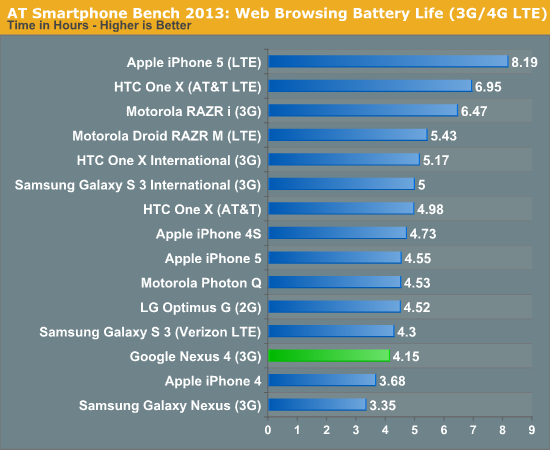
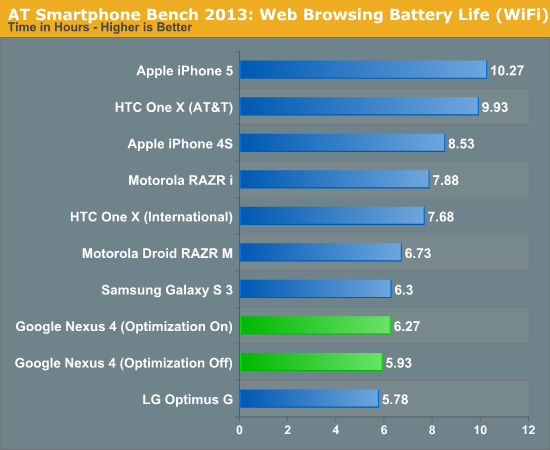
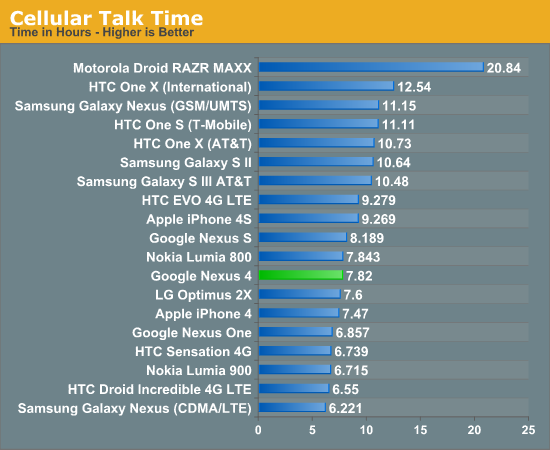
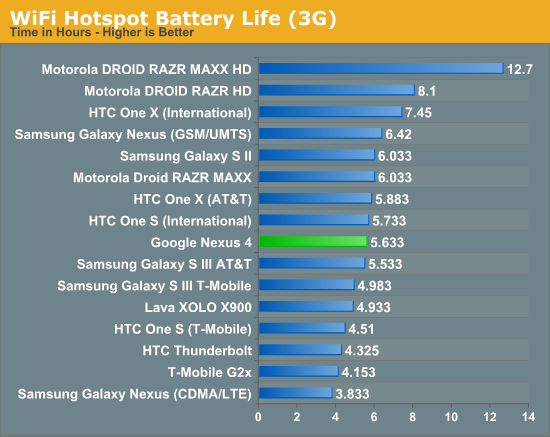
I've run and re-run the battery life tests on the Nexus 4 and they haven't changed since our preview a whole bunch. The result is battery life that isn't really chart topping, yet in my time with the Nexus 4 I haven't really been want for more battery life at any point. I'm able to get through a single day with the device set on auto brightness.



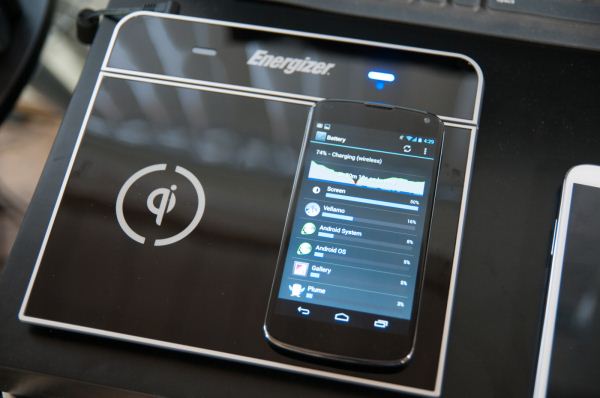

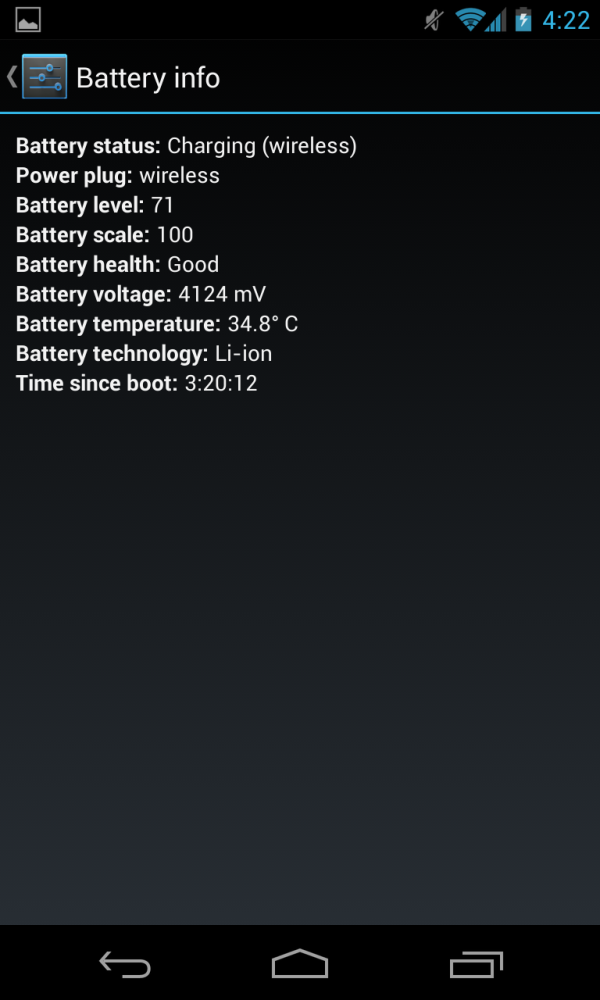








188 Comments
View All Comments
jwwpua - Tuesday, November 13, 2012 - link
Now THAT would be a great way to compare phones. I love the idea of using a hi-speed camera to compare real world tasks.funky247 - Thursday, November 15, 2012 - link
Genius.thesavvymage - Tuesday, November 13, 2012 - link
For those reading, it went up on Google Play at 8:35 pacific, 25 mins ahead of time.BenSkywalker - Tuesday, November 13, 2012 - link
So we know a whole bunch about how the browser performs, and a lot of how Imagination Technologies press demo performs, any chance at some point you may decide to bench the CPU *at all* and perhaps run at least a single meaningful GPU bench?tuxRoller - Tuesday, November 13, 2012 - link
Can we plus one this fella above?I've really been looking forward to a thorough review of the krait architecture (including the new adreno 300 series) but there doesnt appear to be much interest on the AT side to do this.
Reiterating, I'd love to see the same kind of in depth the testing and analysis that was given to Swift. Qualcomm, like apple, is pretty secretive about their products. Performing some targeted tests would go a long ways towards giving us a better picture of the Arm landscape.
madmilk - Tuesday, November 13, 2012 - link
The thermal throttling configuration is very aggressive. According to Nexus 4's thermald.conf, throttling is entirely based on battery temperature, with anything below 36 C giving the full 1.5GHz on the CPU and 400MHz on the GPU. By 39 C, the CPU is only running at 1.2GHz and GPU at 200MHz, which reflects the non-freezer results.shaggles - Tuesday, November 13, 2012 - link
Seriously, with reviews like this I don't have to look anywhere else for tech reviews. Best review I have read in a long time (and the first I read on Anandtech).Great in depth analysis that points out flaws and benefits in a well balanced manner. Great!
I'll be getting this sexy phone!
abhicherath - Tuesday, November 13, 2012 - link
I mean seriously, look at that.In addition to being the best value proposition on the market...
Google's outdone themselves, again.
chrnochime - Tuesday, November 13, 2012 - link
So does the glass back make this phone as brittle as the iphone4/4S?Rits - Tuesday, November 13, 2012 - link
RTFR